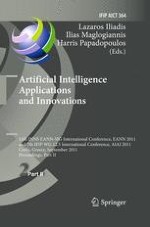The two-volume set IFIP AICT 363 and 364 constitutes the refereed proceedings of the 12th International Conference on Engineering Applications of Neural Networks, EANN 2011, and the 7th IFIP WG 12.5 International Conference, AIAI 2011, held jointly in Corfu, Greece, in September 2011. The 52 revised full papers and 28 revised short papers presented together with 31 workshop papers were carefully reviewed and selected from 150 submissions. The second volume includes the papers that were accepted for presentation at the AIAI 2011 conference. They are organized in topical sections on computer vision and robotics, classification/pattern recognition, financial and management applications of AI, fuzzy systems, learning and novel algorithms, recurrent and radial basis function ANN, machine learning, generic algorithms, data mining, reinforcement learning, Web applications of ANN, medical applications of ANN and ethics of AI, and environmental and earth applications of AI. The volume also contains the accepted papers from the First Workshop on Computational Intelligence in Software Engineering (CISE 2011) and the Workshop on Artificial Intelligence Applications in Biomedicine (AIAB 2011).
